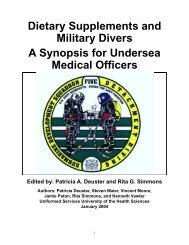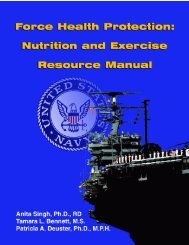Traumatic Brain Injury and Effects of Altitude - Human Performance ...
Traumatic Brain Injury and Effects of Altitude - Human Performance ...
Traumatic Brain Injury and Effects of Altitude - Human Performance ...
You also want an ePaper? Increase the reach of your titles
YUMPU automatically turns print PDFs into web optimized ePapers that Google loves.
<strong>Traumatic</strong> <strong>Brain</strong> <strong>Injury</strong> (TBI) <strong>and</strong> <strong>Effects</strong> <strong>of</strong> <strong>Altitude</strong>:An Analysis <strong>of</strong> the LiteratureAppendixTable 2. Studies <strong>of</strong> altitude-related brain damageAuthor(s), Journal Title Population (N) FindingsFayed et al. (2006)Am J Med, 119,168.e1-168.e6Jersey (2010) AviatSpace EnvironMed, 82, 64-68Paola et al. (2008)European JNeurology, 15,1050-1057Evidence <strong>of</strong> braindamage after highaltitudeclimbing bymeans <strong>of</strong> magneticresonance imagingSevere neurologicaldecompression sicknessin a U-2 pilotReduced oxygen due tohigh-altitude exposurerelates to atrophy inmotor function brainareasCivilianN=35 climbers (12pr<strong>of</strong>essional, 23 amateur)N=20 controlsCase report (N=1)CivilianN=9 world-class climbersN=19 non-exposed controlsMRI evidence <strong>of</strong> irreversible lesions(frontal, parietal) in amateurs <strong>and</strong> diffusecortical atrophy in pr<strong>of</strong>essionals afterclimbing to 4810-8848 meters w/osupplementary oxygen.Pilot who experienced DCS at very highaltitude (cabin pressure 8500 meters).Examination revealed bilateral frontal <strong>and</strong>right cerebellar evidence <strong>of</strong> hypoxia <strong>and</strong>ischemia, as well as persistent cognitiveimpairments <strong>and</strong> balance deficits.Climbers showed subtle white <strong>and</strong> greymatter MRI abnormalities in brain motorcortices after climbing to > 7500 metersw/o supplementary oxygen. Repeatedextreme altitude exposure was associatedwith changes in left primary <strong>and</strong>supplemental motor cortices (right h<strong>and</strong>control). Single exposure was associatedwith changes in left angular gyrus (motorplanning).Table 3. Studies <strong>of</strong> aeromedical transport <strong>of</strong> TBIAuthor(s),Journal Title Population (N)Davis et al.(2005)Annals <strong>of</strong>EmergencyMedicine, 46,115-122Donovan etal. (2008)Aviat SpaceEnviron Med,79, 30-35The impact <strong>of</strong>aeromedicalresponse topatients withmoderate to severetraumatic braininjuryAeromedicalevacuation <strong>of</strong>patients withpneumocephalus:outcomes in 21casesCivilianN = 10,314 totalN = 3,017 local Aeromedtransport by helicoptermoderate & severe TBImean GCS = 9.5MilitaryN=21 head injuries +intracranial air (N=19post-craniotomy)Long-range air transportin pressurized aircraftTBI severity not specifiedOutcome xTBI severityStatisticallysignificantbenefit <strong>of</strong>airtransportfor severeTBI patients(GCS < 9)NRFindingsRetrospective study <strong>of</strong> outcomes foraeromedical vs. ground transport <strong>of</strong>moderate <strong>and</strong> severe TBI patients.Transport altitude not specified.Outcomes were significantly betteroverall for aeromedically transportedTBI patients. Greatest benefitobserved for more severe TBIs (meanGCS = 4.1). Survival improved forpatients intubated during air transportvs. ground transported patientsintubated in emergency department.Retrospective study <strong>of</strong> outcomesamong 21 head injury patients withintracranial air (mean volume 9.3 ml)who underwent long-range airevacuation in pressurized equivalent5000-8000 feet. No patients showedclinical neurological deterioration intransport or within 24 hours <strong>of</strong> arrival.September 14, 2010 38



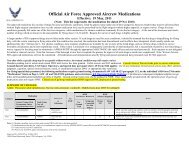
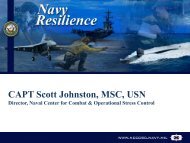
![Body Composition and Military [PDF] - Human Performance ...](https://img.yumpu.com/43269347/1/190x245/body-composition-and-military-pdf-human-performance-.jpg?quality=85)
![Tips for Grocery Shopping [PDF]](https://img.yumpu.com/37447379/1/190x245/tips-for-grocery-shopping-pdf.jpg?quality=85)
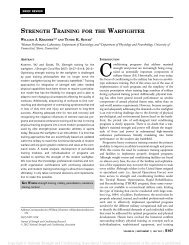
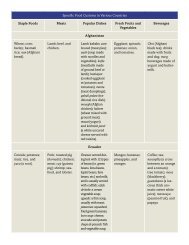
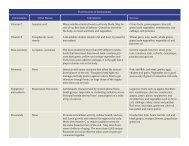
![Synthetic Drugs [PDF] - Human Performance Resource Center](https://img.yumpu.com/37447322/1/190x245/synthetic-drugs-pdf-human-performance-resource-center.jpg?quality=85)
